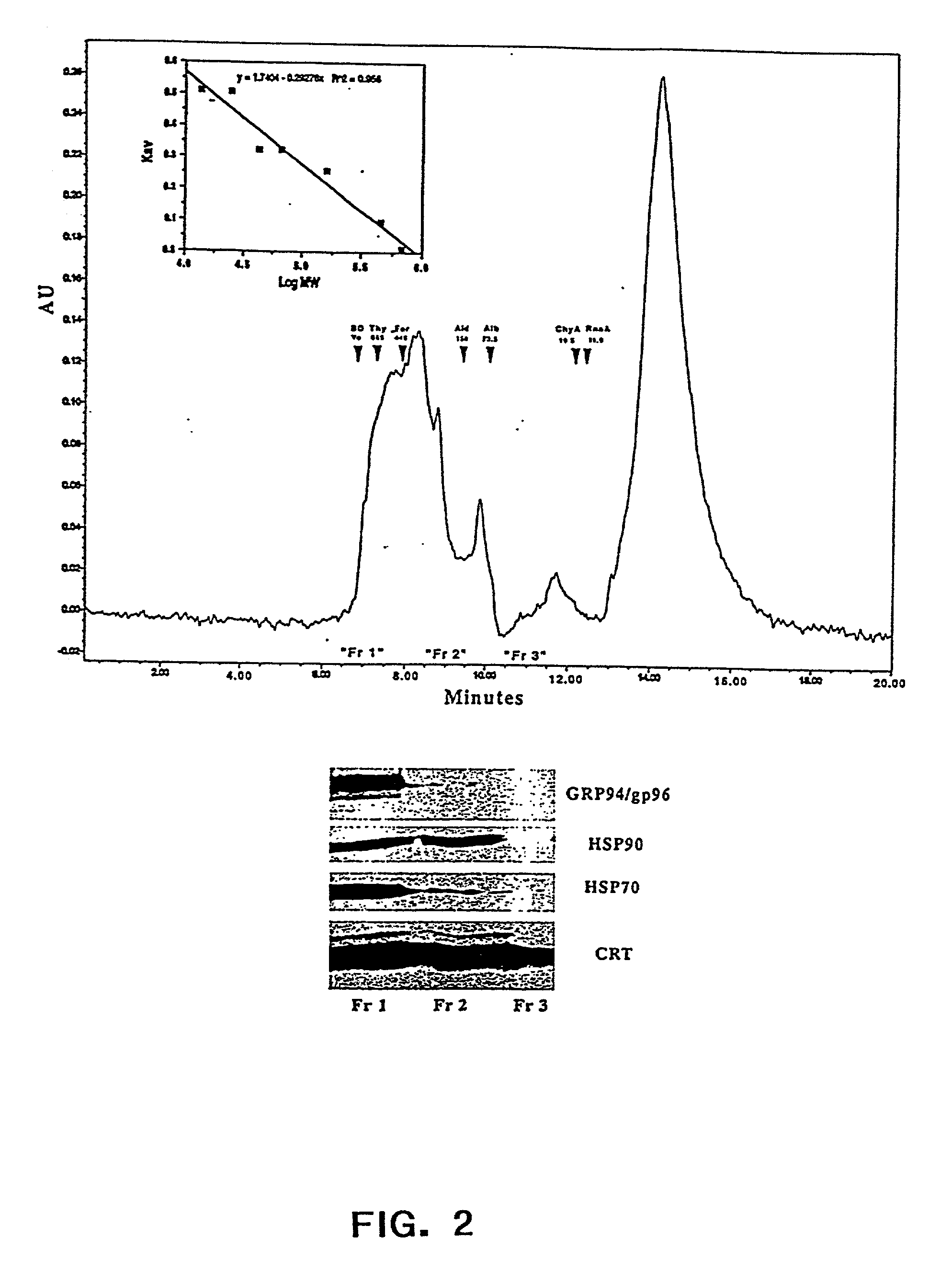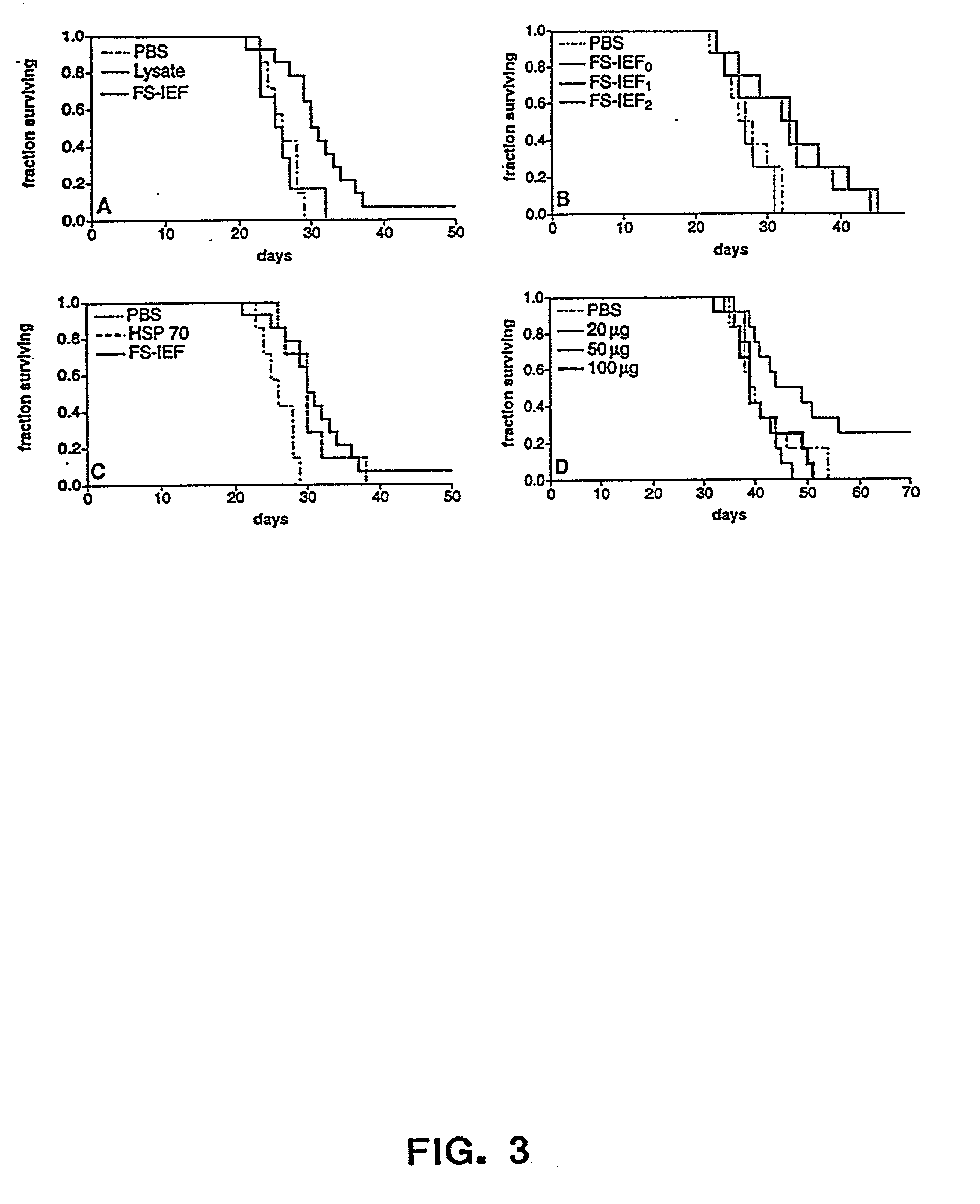0018] The present invention also relates to pharmaceutical compositions. Said pharmaceutical compositions are comprised of chaperone proteins, chaperone protein complexes, or aggregates thereof. The pharmaceutical compositions are obtained from a biological sample e.g. animal cells, mammalian cells, or human cells, by subjecting said sample to IEF and obtaining fractions that are enriched in said chaperone proteins, chaperone protein complexes, or aggregates thereof. The biological sample can include a cell lysate. In a preferred embodiment the IEF is FS-IEF. In another embodiment the pharmaceutical composition is obtained by subjecting said sample to FS-IEF and collecting one or more fractions with a pH in the range of 4.5-6.5 wherein said fractions contain a mixture of chaperone protein complexes, or aggregates thereof, and wherein said chaperone protein complexes, or aggregates thereof, are not purified to homogeneity. Said FS-IEF can be performed in the presence of urea, e.g. at a concentration of 4M-8M or 4M-5M, and detergent, e.g. non-ionic and / or zwitterionic. Said collected fractions may be dialyzed against a buffer e.g. phosphate buffered saline. The pharmaceutical compositions obtained by FS-IEF can comprise any chaperone protein, chaperone protein complex, or aggregate thereof, e.g calreticulin (CRT), gp96, grp75 / mt, BiP / grp 78, hsp 90, hsp 72, hsp 60, and hsp70, hsp 40 or any one or more of the foregoing. In a specific embodiment the pharmaceutical composition obtained by FS-IEF comprises GRP94 / gp96, hsp 90, hsp 70, and calreticulin. In another specific embodiment, the pharmaceutical composition obtained by FS-IEF comprises GRP94 / gp96, hsp 90, hsp 70, hsp 72, hsp 60, hsp 40, calreticulin, BiP / grp 78, and grp75 / mt. The pharmaceutical composition obtained by FS-IEF can also comprise noncovalent complexes of chaperone proteins and different peptides. The invention also relates to a kit comprising in one or more containers the pharmaceutical composition obtained by FS-IEF.
0019] The invention also relates to methods of treating or preventing cancer in a subject comprising administering to said subject a therapeutically or prophylactically effective amount of a pharmaceutical composition comprised of FS-IEF enriched chaperone proteins, chaperone protein complexes, or aggregates thereof. The chaperone proteins can be derived from a cell lysate e.g. a lysate of cancer cells of the type of cancer in the subject, or metastasis thereof.
0020] The invention also relates to a method of treating or preventing a type of cancer in a subject, wherein said method comprises subjecting a lysate of cells of a cancer of said type, or metastasis thereof, to FS-IEF; collecting one or more fractions with a pH from pH 4.5 to 6.5 which are enriched in chaperone protein complexes; optionally pooling said collected fractions; and administering said chaperone protein complexes present in said collected fractions to a patient to treat or prevent said cancer. Said subject can be any animal, preferably a mammal, more preferably a human. Said free solution isoelectric focusing can be performed in the presence of urea and detergent. The urea can be present in the range of 4M-8M. The detergent can be present at concentration in the range of 0.1%-1.7%. The detergent can be non-ionic or zwitterionic e.g. Triton X-100, Triton X-114, and / or Igepal CA-630. The detergents can be removed from the fractions collected from FS-IEF prior to use, e.g., by dialyzing the collected fractions against a buffer comprising phosphate buffered saline or water. FS-IEF can be performed in the presence of a salt e.g. sodium chloride. The chaperone protein complexes can be present in aggregates that have a molecular weight that is greater than 100 kD, 200 kD, 300 kD, 400 kD, or 500 kD. The method of the invention further includes combining the chaperone protein complexes obtained in FS-IEF fractions with a biological response modifier e.g. IL-2, IL-4, IL-5, IL-6, IL-12, IL-15, GM-CSF.
0021] The invention also relates to a method of treating or preventing a disease caused by an infectious agent, e.g. a virus, a bacterium, or a parasite, in a subject, wherein said method comprises subjecting a lysate of cells expressing an antigenic molecule displaying antigenicity of an antigen of said infectious agent to FS-IEF; collecting one or more fractions with a pH from pH 4.5 to 6.5 which are enriched in chaperone protein complexes; optionally pooling said collected fractions; and administering said chaperone protein complexes present in said collected fractions to a patient to treat or prevent said disease. Said cell lysate can be of cells transformed with a nucleic acid encoding said antigenic molecule or alternatively the cells can be infected with said infectious agent. Said FS-IEF can be performed in the presence of urea and detergent. The urea can be present in the range of 4M-8M. The detergent can be present at concentration in the range of 0.1%-1.7%. The detergent can be non-ionic or zwitterionic e.g. Triton X-100, Triton X-114, and / or Igepal CA-630. The detergents can be removed from the fractions collected from FS-IEF prior to use. FS-IEF can be performed in the presence of a salt e.g. sodium chloride. The method of the invention includes combining the chaperone protein complexes obtained in FS-IEF fractions for the treatment or prevention of a disease caused by an infectious agent with a biological response modifier e.g. IL-2, IL-4, IL-5, IL-6, IL-12, IL-15, GM-CSF.
0022] The invention also relates to methods of treating or preventing an infectious disease in a subject by administering to said subject a therapeutically or prophylactically effective amount of a pharmaceutical composition comprising FS-IEF enriched chaperone proteins, chaperone protein complexes or aggregates thereof. The chaperone proteins can be derived from a cell lysate e.g. cells expressing an antigenic molecule displaying the antigenicity of an antigen of said infectious agent.
0023] The invention also relates to methods of eliciting an immune response against an antigen in a subject comprising administering to said subject a therapeutically or prophylactically effective amount of a pharmaceutical composition comprising FS-IEF enriched chaperone proteins, chaperone protein complexes or aggregates thereof. Said pharmaceutical composition can be obtained by subjecting a biological sample to FS-IEF and collecting one or more fractions with a pH in the range of 4.5-6.5 wherein said fractions contain a mixture of chaperone protein complexes, or aggregates thereof, and wherein said chaperone protein complexes, or aggregates thereof, are not purified to homogeneity.
 Login to View More
Login to View More 


